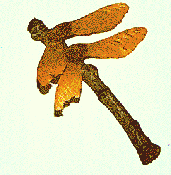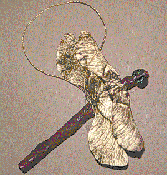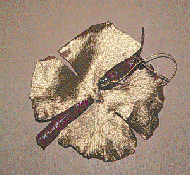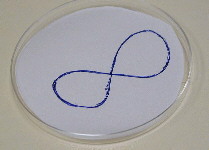 WEE BEASTIES
WEE BEASTIES
 WEE BEASTIES
WEE BEASTIES
Entomology Newsletter for Teachers
Volume 2, Issue 1 University of Kentucky – Department of Entomology Fall 1999
Monarchs Many people think of monarchs in the fall. They have been used in the classroom for education for years. What an excellent way to show the complete metamorphosis of an insect! Monarchs are easy to rear on milkweed and soon turn into a beautiful chrysalis eventually to emerge as a butterfly. To find these caterpillars, search on leaves of milkweed plants-a sign of their presence might be some droppings or holes in the leaves. Students are fascinated with live critters in the classroom. See our publication on Classroom Mascots at:
http://www.uky.edu/Agriculture/Entomology/ythfacts/resourc/mascots.htm
Many people think of monarchs in the fall. They have been used in the classroom for education for years. What an excellent way to show the complete metamorphosis of an insect! Monarchs are easy to rear on milkweed and soon turn into a beautiful chrysalis eventually to emerge as a butterfly. To find these caterpillars, search on leaves of milkweed plants-a sign of their presence might be some droppings or holes in the leaves. Students are fascinated with live critters in the classroom. See our publication on Classroom Mascots at:
http://www.uky.edu/Agriculture/Entomology/ythfacts/resourc/mascots.htm
The migration of the monarch is tracked through Monarch Watch. Your classroom can be involved in this activity of tagging monarchs and recording sightings. An interactive web site for students and teacher is http://www.monarchwatch.org/
Flour Beetles in the Classroom
Go to top
 Flour beetles are small, oval, flat beetles, which can be pests in home pantries, mills, and warehouses. There are two common species; a dark brown to black confused flour beetle and the red flour beetle. The red species seems to be a little heartier than the confused flour beetle.
These critters are easy to maintain and perfect for science activities in the classroom. They could be used for inquiry (KERA standard 2.1,) in an extended study of food preference. Flour beetles thrive in flour, nothing added - just flour, which would be a suitable control. Have students bring in food types for which to compare the growth rate of the beetles. Suggestions include oatmeal, bran flakes, breakfast cereal, wheat germ, cornmeal, or cake mix. If cereal is used, it should be crushed. Fill baby food jars or any small containers, half full of food choice and place equal number of beetles (at least 10) in each jar. Count the number of beetles every three or four weeks by pouring the contents of the jar into a petri dish or flat pan. Record number of adults and describe the immatures. Graph the numbers over time.
Flour beetles are small, oval, flat beetles, which can be pests in home pantries, mills, and warehouses. There are two common species; a dark brown to black confused flour beetle and the red flour beetle. The red species seems to be a little heartier than the confused flour beetle.
These critters are easy to maintain and perfect for science activities in the classroom. They could be used for inquiry (KERA standard 2.1,) in an extended study of food preference. Flour beetles thrive in flour, nothing added - just flour, which would be a suitable control. Have students bring in food types for which to compare the growth rate of the beetles. Suggestions include oatmeal, bran flakes, breakfast cereal, wheat germ, cornmeal, or cake mix. If cereal is used, it should be crushed. Fill baby food jars or any small containers, half full of food choice and place equal number of beetles (at least 10) in each jar. Count the number of beetles every three or four weeks by pouring the contents of the jar into a petri dish or flat pan. Record number of adults and describe the immatures. Graph the numbers over time.
Flour beetles may be purchased from biological supply companies such as Carolina Biological Supply catalog (see catalogs and resources at the end of this newsletter). They may also be found in opened flour containers or other common grain products found in a kitchen.
For more description of flour beetles and other activity ideas using flour beetles, go to the web site.
http://www.uky.edu/Agriculture/Entomology/ythfacts/resourc/resourc.htm
Sticks, Leaves, Seeds... and Insects!
Go to top
Fall is also a good time to make insect ornaments for mobiles, Christmas ornaments or to hang in a window. Dragonflies, beetles, and butterflies may be some of the creations.
Use straight sticks, 3-4 inches long, and 4 maple seeds. Very small seeds or beads can be glued on one end of the stick for eyes.
With green eyes, red bodies, and gold wings, dragonflies make excellent Christmas tree
ornaments!
http://www.uky.edu/Agriculture/Entomology/ythfacts/allyr/ornament.htm
 |  |  |
Termite Tracking
 An excellent first day activity or reinforcement of the scientific method and inquiry involves chemical communication with termites. This is geared towards middle school or high school students. Termites are attracted to a chemical in the ink of Papermate or most any ballpoint pens. They do not respond to rollerballs or felt tips. They will not respond to all inks or to pencil or colored pencil. The termites will follow whatever design is drawn as long as the lines are heavy and fairly well spaced. A figure eight works well but this can be experimented with as well. The ink, which attracts the termites, has a substance that resembles the pheromones that the termite recognizes.
An excellent first day activity or reinforcement of the scientific method and inquiry involves chemical communication with termites. This is geared towards middle school or high school students. Termites are attracted to a chemical in the ink of Papermate or most any ballpoint pens. They do not respond to rollerballs or felt tips. They will not respond to all inks or to pencil or colored pencil. The termites will follow whatever design is drawn as long as the lines are heavy and fairly well spaced. A figure eight works well but this can be experimented with as well. The ink, which attracts the termites, has a substance that resembles the pheromones that the termite recognizes.
 Have students cut a piece of paper to fit the inside of a petri dish and draw a large figure eight on the paper with the ballpoint pen. They need to go over it several times. Place it in the petri dish. The termites are soft bodied so students need to be very careful when they use the forceps or tweezers to place them into the petri dish. Students make observations and record their data in a table which includes the headings of positive response +, no response O, or avoidance -. Students may test as many other pens and pencils as available and record the data. They might try different designs and see the reaction of the termites. Students should make conclusions about the observations and give a scientific explanation as to why the termites respond as they do.
Have students cut a piece of paper to fit the inside of a petri dish and draw a large figure eight on the paper with the ballpoint pen. They need to go over it several times. Place it in the petri dish. The termites are soft bodied so students need to be very careful when they use the forceps or tweezers to place them into the petri dish. Students make observations and record their data in a table which includes the headings of positive response +, no response O, or avoidance -. Students may test as many other pens and pencils as available and record the data. They might try different designs and see the reaction of the termites. Students should make conclusions about the observations and give a scientific explanation as to why the termites respond as they do.
A discovery type learning would be to use a blue ballpoint and another blue pen with no effect and ask "Why does this happen?" and then turn them loose to try different things. As a group, discuss what can be concluded and explain why this happens. Have students predict what will happen with different colors and what hypotheses for red ballpoint versus blue and green. It turns out the termites are blind and color should have no effect on the termite tracking.
Termites may be found in decaying logs and stumps in wooded areas. When it gets too dry they burrow down in the soil looking for moisture. They can also be ordered from Carolina Biological. Termites may last a few weeks if they have wood and are kept moist. I had couple of generations and was able to keep them going the whole year with very low maintenance.
This lab on Termite Tracking was adapted from one created by Lana Hayes of Simon Kenton High School in Independence, KY.
Did You Know?
Book Review
 | Meet the Arthropods..., by Ellen Doris, 1996 Thames and Hudson inc., New York. This book provides great ideas for studying arthropods, with a large emphasis on insects. It gives ideas on where to find specific critters and excellent photographs for identifying a specimen. The book shows how to raise, feed, and study certain insects such as a praying mantid. It is suitable for children nine and up. |
 | The Insect Almanac A Year-Round Activity Guide, by Monica Russo. 1991, Sterling Publishing Company, Inc. More ideas on where to collect insects and how to preserve are provided in this book. There are practical ways on how to display your insects and how they need to be mounted. Ideas for each season are beautifully described. |
Announcements
Catalogs and Supplies
Carolina Biological Supply Company
2700 York Rd.
Burlington, NC 27215-3398
Telephone for Orders: 1-800-334-5551
Fax: 1-800-222-7112
Technical Support: 1-800-227-1150
Wards Natural Science Establishment, Inc.
P.O. Box 92912
Rochester, New York 14692-9012
Customer Service and Ordering
Telephone: 1-800-962-2660
Fax Ordering: 1-800-635-8439
Catalog Request Only: 1-800-892-3583
BioQuip Products Inc. A Note from the Editor:
17803 LaSalle Avenue
Gardena, CA 90248-3602
Telephone: 310-324-0620
Fax: 310-324-7931
e-mail: bioquip@aol.com
Lana Unger began this newsletter about a year ago. She has moved to Idaho and I have taken her responsibilities. Previously, I taught seventh grade and high school science. I look forward to serving you in any way I can.
If you have ideas, experiences, or information that you would like to share or would like information about educational resources available through the University of Kentucky, Department of Entomology, write, phone, or email:
Blake Newton
S-225 Agriculture Science Center - North
University of Kentucky
Lexington, KY 40546-0091
859-257-5107
Email: blnewt00@pop.uky.edu
View and print Wee Beasties in the Adobe Acrobat (tm) PDF format. The Adobe Acrobat (tm) PDF format allows you to download, view, search, and print, while maintaining the original printed look of the document. You will need the (free) plug-in to read PDF documents.
Go to top
Educational Programs of the Cooperative Extension Service serve all people regardless of race, color, age, sex, religion, disability, or national origin. UNIVERSITY OF KENTUCKY, KENTUCKY STATE UNIVERSITY, DEPARTMENT OF AGRICULTURE AND KENTUCKY COUNTIES COOPERATING.